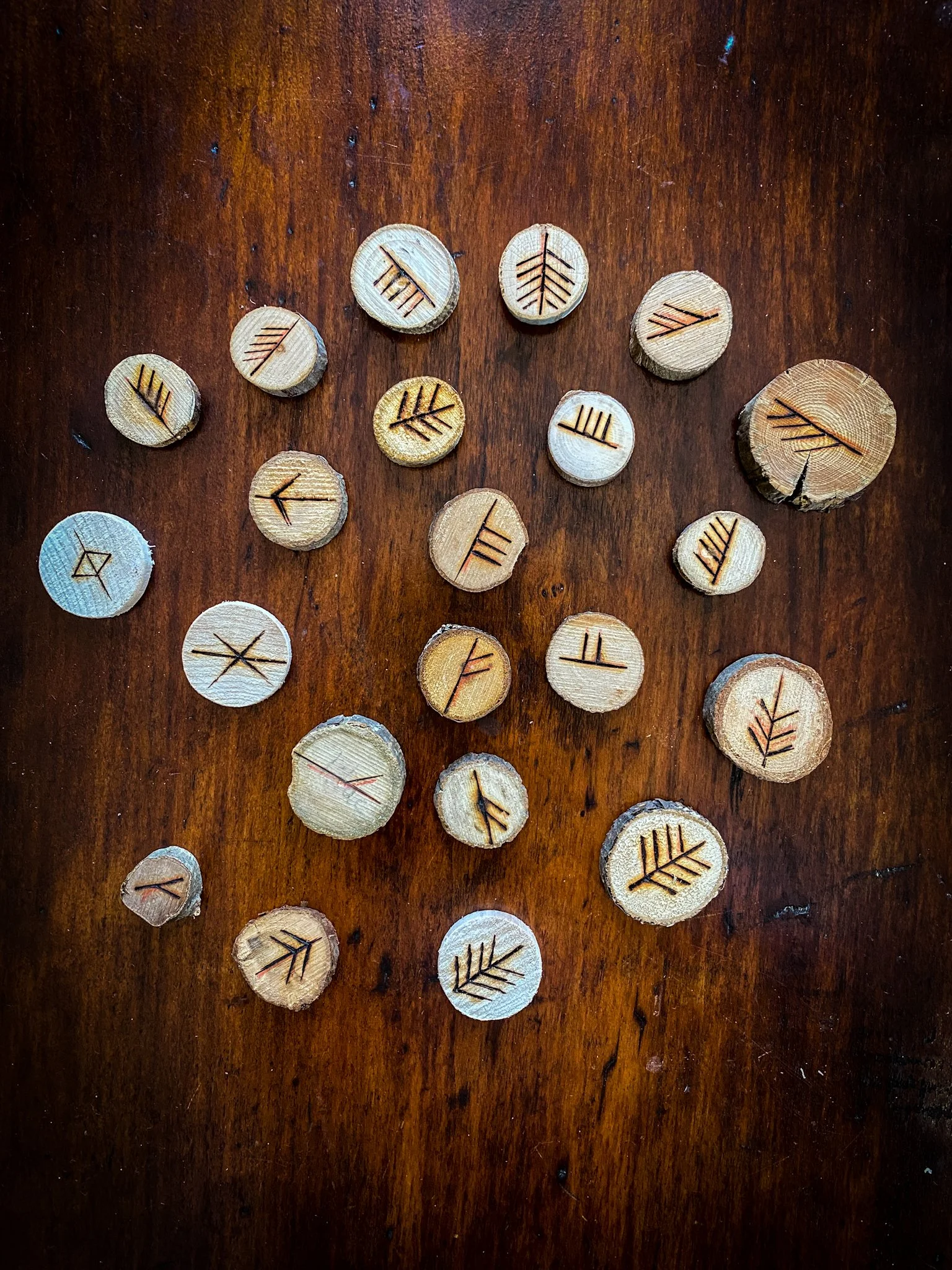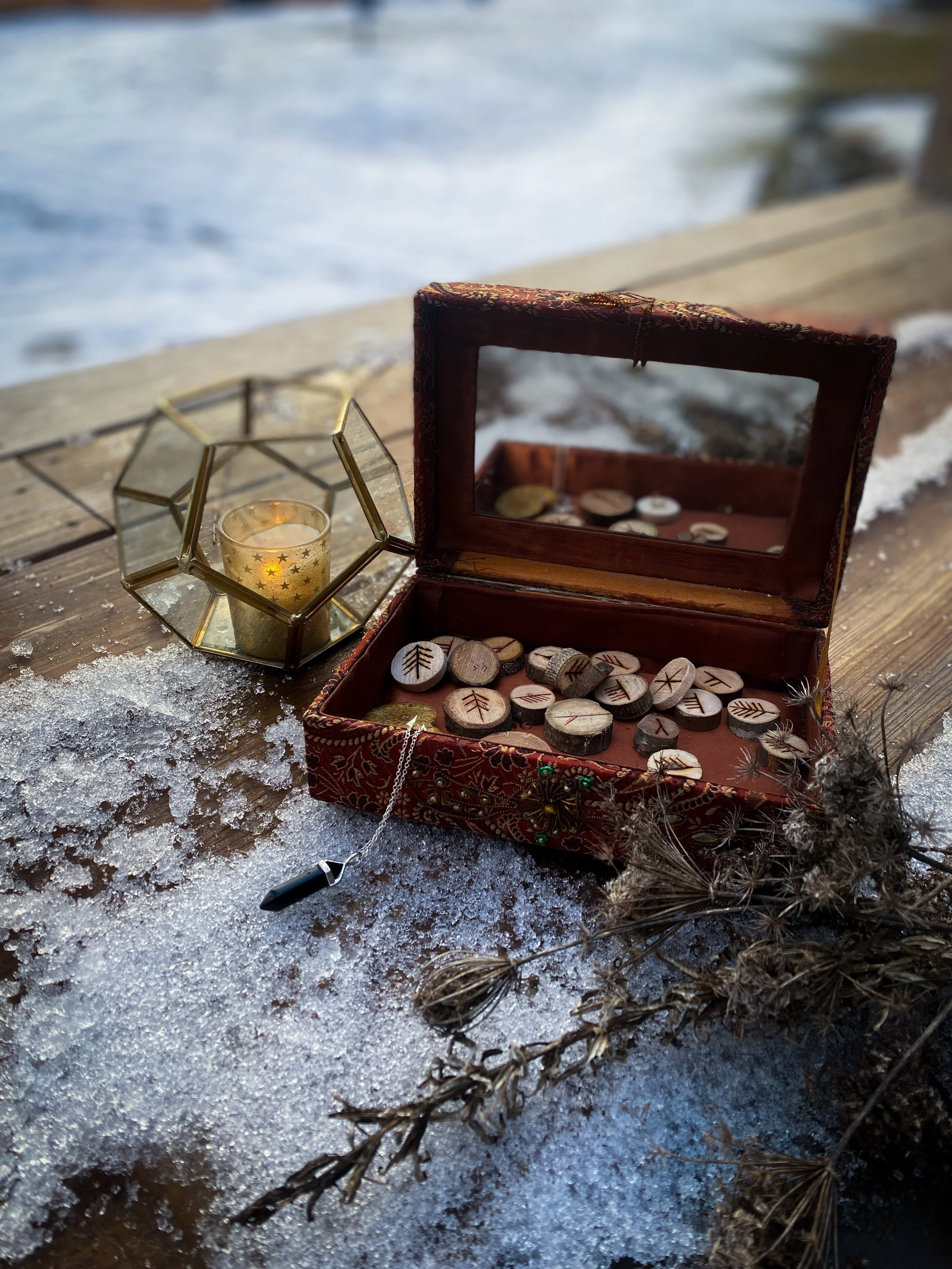Celtic Tree Oracles, an initiation into the ogham
Hand carved and woodburned ogham set I am working on. Still missing a few….can you tell which?
I’ve become more interested in identifying trees this year than previous years. In the dormant days of winter, when the ice and snow make it impossible to forage for herbs, my eyes become more attuned to the trees, discerning the familiar and unfamiliar patterns and textures of the bark, the buds, and the branches. For me, winter tree ID takes time and repetition, but I’ve noticed I’ve definitely gotten better at recognizing several species that grow around me this season, such as red maple, sugar maple, white oak, linden, bigtooth aspen, white ash, hickory, balsam fir, among other beloved and highly recognizable old friends like eastern hemlock and all the birches and beeches I have always adored.
Leafless winter trees have a way of capturing the imagination. To me, the look of their bare limbs against the pale winter sky makes the tree beings appear closer, somehow, more accessible even than they do when they are all decked out in their green summer garb. Maybe it’s because they look so vulnerable without the glory of their leaves, but I feel even more comfortable to reach out with my mind and speak with them. I sympathize with their sleepy, withdrawn winter vibes, and the creaks and moans they make in the chilly wind sound more human to my ears.
Winter tree communication is made easier and more efficient with the help of the Ogham - the beautiful and mysterious Celtic tree alphabet. When I first heard of the ogham, I thought it was so beautiful it made my heart ache. But despite the way it pulled at my heartstrings to think of an ancient alphabet made from the knowledge of trees, I didn’t pay it too much mind at first, because I’ve learned to be skeptical of much of the neo-pagan beliefs about the origins of Celtic spirituality. I assumed it must be a new age invention - another system created from the wistful imaginations of those who read too much historical fantasy. I just didn’t buy that something so relevant to contemporary paganism could be based on any real historical truths about the Celts. But no! Turns out Ogham (pronounced “oh-um” and originally spelled ogam) is not just a new age fad, but an honest-to-goodness system of written symbols carved into stone and wood between 300 and 600 CE in Ireland.
The alphabet was said to have been invented by the god Ogma mac Elathan, a divine poet as well as a warrior and brother to the Great God himself, The Dagda. The legends say that Ogma “created the ogam to demonstrate his intellectual skill, and that the system was intended to be used by the learned classes alone” (MacLoed, Celtic Myth and Religion 2012). Supposedly the first use of ogam was to encode a piece of birch with a talismanic protection symbol. This symbol, known as Beithe, or, B for Birch, was both a message of warning and a spell of protection for the god Lug’s wife (MacLoed, 107).
Of course the contemporary use of ogham as a divinatory tool is both an oversimplification and embellishment on its origins, and much has been lost to time and erosion. But the same can be said for any alphabet, no? And indeed, what remains of the ogham and what has been added and honed over the years are just so lovely and rich, I am completely smitten; I foresee many years of study ahead of me as I develop a deeper relationship with these symbols and the trees they connect us with. I only hope my Tarot cards do not get jealous!
One of my absolute favorite things about the Celtic tree system is the poetic kennings, or two-worded poetic names that are associated with each tree or letter. These are known as Briatharogam, and they come from manuscripts written down by medieval Monks.
For example, for Beithe, of Birch and the Letter B, we have the kennings:
Withered foot with fine hair; Greyest of skin; Beauty of the eyebrow
And for Willow, or Sail and the letter S:
Pallor of a lifeless one; Sustenance of Bees; Beginning of honey.
At first these may seem confusing, and not at all easy to interpret if you’re looking for a quick divination guide. But I love how the poetry of these descriptions hints at the cultural and symbol significance of the trees to those long-ago tree worshiping Druids and the peoples they priested over. I love the anthropomorphic images they conjure. But mostly I love how they defy the logic of the analytical brain - the part that wants definitions and fixed explanations and facts. No, kennings do not offer logic. They work through the magic of association and image - exactly the way our minds store memory in an unconscious way. I don’t know about you, but after reading the kenning for Sail, I will forever picture little bees gorging themselves on the pussy willow pollen when I think of a willow tree. Druids were masters of memory, afterall. As part of their training they had to record to memory all the sacred histories, prayers, lineages, poems and stories of their time and to be able to recall them at will. So yes, kennings are useful, and magical, and they encode deep meaning and symbolism in just a few words.
As part of my botanomancy practice, I will be focusing on different ogham throughout this year. In addition to Tarot and the other divination practices I bring to my devotional and spiritual path, I am thrilled to be sharing more ogham with you in the months ahead.
A quick pull from my ogham set at sunset for a short winter divination reading.
If you’re looking for resources on the Ogham, a good place to begin with the alphabet is here Ogham in 3D (dias.ie)
Also, the Irish Pagan School has a good free introductory course on the Ogham that goes over the importance of respecting the native wisdom and learning from native Irish teachers.


